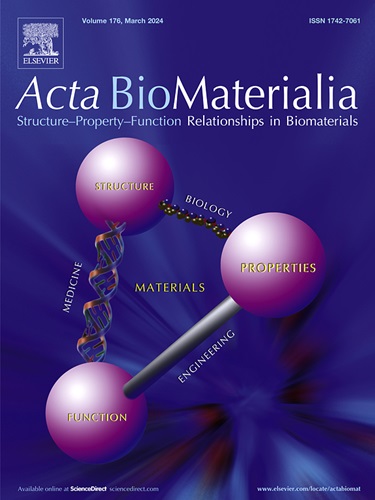粘弹性水凝胶培养的肌纤维揭示了整合素结合和机械传感对肌肉卫星细胞的影响。
IF 9.4
1区 医学
Q1 ENGINEERING, BIOMEDICAL
引用次数: 0
摘要
位于肌纤维上的静止骨骼肌卫星细胞(SCs)在肌肉损伤后激活以再生肌肉;然而,确定特定基质信号在体内SC行为中的作用是困难的。因此,我们开发了一种具有可调特性的粘弹性水凝胶,在保持干细胞生态位极性和SC-肌纤维相互作用的同时包裹肌纤维,以研究基质信号(包括粘弹性和整合素结合配体精氨酸-甘氨酸-天氨酸(RGD))如何影响肌肉再生过程中的SC行为。粘弹性水凝胶支持肌纤维培养,同时在包埋后72小时内保持SC干性,与Matrigel相比,最大限度地减少肌纤维过度收缩和SC过度增殖。Pax7在高应力弛豫水凝胶包埋的肌纤维上连续表达,而包埋在弹性水凝胶中的SCs分化。光镜显示,RGD浓度的增加激活SCs并将YAP/TAZ转运到细胞核中。删除YAP/TAZ可消除RGD介导的SC活化,因此,YAP/TAZ可介导RGD配体诱导的SC活化和随后的增殖。意义声明:卫星细胞(SCs)负责肌肉维持和再生,但细胞外基质如何调节SC功能尚不清楚,新的生物材料模型可以概括体外SC生态位的复杂性。在分离肌纤维后,SCs退出静止状态,被激活。为了解决这个问题,我们开发了一种粘弹性水凝胶来包裹肌纤维,它可以保持SC静止并限制分化,从而可以研究RGD效应。我们发现RGD浓度的增加促进了激活并抑制了分化。最后,为了利用高分辨率成像来解析YAP/TAZ转录共激活因子的亚细胞定位,我们应用光镜扩增和凝胶-凝胶转移技术来量化YAP/TAZ核质比,揭示rgd介导的激活依赖于YAP/TAZ核易位。本文章由计算机程序翻译,如有差异,请以英文原文为准。

Myofibers cultured in viscoelastic hydrogels reveal the effects of integrin-binding and mechanosensing on muscle satellite cells
Quiescent skeletal muscle satellite cells (SCs) located on myofibers activate in response to muscle injury to regenerate muscle; however, identifying the role of specific matrix signals on SC behavior in vivo is difficult. Therefore, we developed a viscoelastic hydrogel with tunable properties to encapsulate myofibers while maintaining stem cell niche polarity and SC-myofiber interactions to investigate how matrix signals, including viscoelasticity and the integrin-binding ligand arginyl-glycyl-aspartic acid (RGD), influence SC behavior during muscle regeneration. Viscoelastic hydrogels support myofiber culture while preserving SC stemness for up to 72 hours post-encapsulation, minimizing myofiber hypercontraction and SC hyperproliferation compared to Matrigel. Pax7 is continuously expressed in SCs on myofibers embedded in hydrogels with higher stress relaxation while SCs differentiate when embedded in elastic hydrogels. Increasing RGD concentrations activates SCs and translocates YAP/TAZ to the nucleus as revealed by photo-expansion microscopy. Deleting YAP/TAZ abrogates RGD-mediated activation of SCs, and thus, YAP/TAZ mediates RGD ligand-induced SC activation and subsequent proliferation.
Statement of significance
Satellite cells (SCs) are responsible for muscle maintenance and regeneration, but how the extracellular matrix regulates SC function is less understood and would benefit from new biomaterial models that can recapitulate the complexity of SC niche in vitro. Upon isolation of myofibers, SCs exit quiescence, becoming activated. To circumvent this issue, we developed a viscoelastic hydrogel for encapsulating myofibers, which maintains SC quiescence and limits differentiation, allowing the study of RGD effects. We showed that increasing RGD concentration promotes activation and suppresses differentiation. Finally, to allow high resolution imaging for resolving the subcellular localization of YAP/TAZ transcriptional co-activators, we applied photo-expansion microscopy and gel-to-gel transfer techniques to quantify YAP/TAZ nuclear-cytoplasmic ratio, revealing that RGD-mediated activation relies on YAP/TAZ nuclear translocation.
求助全文
通过发布文献求助,成功后即可免费获取论文全文。
去求助
来源期刊

Acta Biomaterialia
工程技术-材料科学:生物材料
CiteScore
16.80
自引率
3.10%
发文量
776
审稿时长
30 days
期刊介绍:
Acta Biomaterialia is a monthly peer-reviewed scientific journal published by Elsevier. The journal was established in January 2005. The editor-in-chief is W.R. Wagner (University of Pittsburgh). The journal covers research in biomaterials science, including the interrelationship of biomaterial structure and function from macroscale to nanoscale. Topical coverage includes biomedical and biocompatible materials.
 求助内容:
求助内容: 应助结果提醒方式:
应助结果提醒方式:


